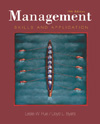 |  Management: Skills and Application, 10/e Leslie W Rue,
Georgia State University - Emeritus
Lloyd L Byars,
Georgia Institute of Technology
Managing Change and Culture
Chapter Summary| 1. Identify the three major categories of organizational change. The three major categories of organizational change are technological changes, environmental changes, and changes internal to the organization.
2. List the three steps in Lewin's model for change. Lewin's model for change involves three steps: unfreezing, presenting a new alternative, and refreezing.
3. Discuss several reasons employees resist change. Employees resist change for many reasons. Six of the most frequently encountered reasons are (1) fear of the unknown, (2) economics, (3) fear that expertise and skills will lose value, (4) threats to power, (5) inconvenience, and (6) threats to interpersonal relations.
4. Identify several prescriptions for reducing resistance to change. Just as there are many reasons employees resist change, there are many approaches for reducing resistance to change. Several suggestions for reducing resistance to change include (1) building trust between management and employees; (2) discussing upcoming changes with affected employees; (3) involving employees in the change process as early as possible; (4) ensuring that the proposed changes are reasonable; (5) avoiding threats; and (6) following a sensible time schedule for implementing the change.
5. Summarize the four phases of an organizational development (OD) program. Most OD efforts include a diagnosis phase, a change-planning phase, an intervention/education phase, and an evaluation phase. Diagnosis involves gathering and analyzing information to determine the areas of the organization in need of improvement. Change planning involves developing a plan for organization improvement. Intervention/education involves the sharing of diagnostic information with the people affected by it and helping them to realize the need for change. The evaluation phase attempts to determine the effects the OD effort has had on the organization.
6. Briefly describe four essential principles that organizations must follow to manage innovation. Essential principles for successfully innovating are (1) have a comprehensive approach, (2) include a systematic, organized, and continued search for new opportunities, (3) involve everyone in the innovation process, and (4) work constantly on improving the organization's climate for innovation.
7. Define corporate culture. Corporate culture communicates how people in the organization should behave by establishing a value system conveyed through rites, rituals, myths, legends, and actions. Simply stated, corporate culture means "the way we do things around here."
8. Describe the generic types of organizational culture. The tough-person, macho culture is characterized by individualists who regularly take high risks and get quick feedback on whether they are right or wrong. The work-hard/play-hard culture encourages employees to take few risks and to expect rapid feedback. The bet-your-company culture requires big-stakes decisions with considerable time lags before the results are known. The process culture involves low risk coupled with little feedback; employees must focus on how things are done rather than on the outcomes. |
|



 2003 McGraw-Hill Higher Education
2003 McGraw-Hill Higher Education